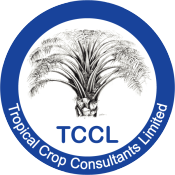In 1990, Thomas Fairhurst started an assignment with GIZ as Agronomy Adviser to the 4,800 ha Ophir smallholder oil palm project. Large amounts of agronomic data were available in ledger books, spreadsheets, and paper files.
The challenge was to organise the data so that data analysis was possible. Whilst spreadsheets can be used to store agronomic data for a single topic (e.g., leaf analysis) for a single year, they are not suitable for storing data for multiple topics (e.g., production, leaf and soil analysis, pest and disease occurrence, palm census) over multiple years.
To store data for complex datasets, a database structure must be employed. The key step in development was to combine the skills of a database programmer (Armin gfroerer-Kerstan) and an agronomist (Thomas Fairhurst) and first make a systems analysis.
How to structure the data in a database programme? Initially we opted for collecting yearly data for multiple topics. We were fortunate that Helmut von Uexkull, a visiting consultant at the Ophir Project, provided examples of the Lonsum Clipcards (Figure 1a and 1b), an early analogue approach to storing agronomic data for individual blocks that was designed by Eric Rosenquist, consultant agronomist at Harrison’s and Crosfield.

Figure 1a. Lonsum Clip card produced by Harrisons and Crosfield in the 1960s.

Figure 1b. Lonsum Clip card produced by Harrisons and Crosfield in the 1960s.
The Lonsum Clipcards could be used to store basic information (e.g., block soil type, topography, year of planting) as well as yearly data for key parameters (e.g., production, leaf analysis, fertilizer application). For basic parameters (e.g., topography), several holes arranged around the card perimeter for key parameters provided the means to sort data (e.g., all blocks with flat topography) by inserting a needle through the respective unclipped hole.
Eric Rosenquist predicted that the analogue system would later be adapted as a computer database programme (Rosenquist, 1975). The first version of OMP (Oil palm Monitoring Programme) was ready for use in 1991. OMP could produce block history reports showing past production data, as well as leaf analysis fertilizer application data (Figure 2).

Figure 2. Block nutrients report produced by OMP in the Ophir Project in 1993.
OMP was commercialised in 1998 and since then it has been licensed for use over 700,000 ha in 13 countries. Since then, OMP has undergone multiple improvements and OMP 9, the latest release, now includes tools for monitoring long-term crop budgets (10 year period), annual crop budget, crop forecasting, daily production monitoring, crop loss audits, and field auditing. Significantly, we have designed a decision support tool for the preparation of fertilizer recommendations. The design has been streamlined and updated and now provides the user with the means to record, monitor and analyse all aspects of plantation agronomy.
At present, Agrisoft Systems is working with TCCL to produce a smartphone app for field data recording and tools in OMP for resources use efficiency (labour, materials, and machines).
Our goal is to equip oil palm managers and agronomists with tools to analyse all physical data in oil palm plantations because we think that by close monitoring of all physical data (plantation agronomy data, resource use (labour, materials and machine use) managers can evaluate yield intensification programmes effectivley.
For more history, read Rosenquist (1975).
